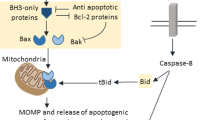Abstract
The nuclear pore membrane protein POM121 is specifically degraded during apoptosis by a caspase-3-dependent process enabling early detection of apoptosis in living cells expressing POM121-GFP. Here we further investigated temporal aspects of apoptotic degradation of POM121-GFP. We demonstrate that decreased POM121-GFP fluorescence precedes annexin V-labelling of apoptotic cells. This indicates that degradation of the nuclear pore complex starts prior to redistribution of plasma membrane phosphatidylserine, which serves as a signal for phagocytotic elimination of apoptotic cells. Furthermore, a caspase-resistant GFP-labelled mutant of POM121 resisted degradation even in late apoptosis and was detected in clustered nuclear pores. Thus, it can be concluded that loss of POM121-GFP is a specific sensor of the activation of caspase-3-dependent proteolysis at the nuclear pores.
Similar content being viewed by others
References
Ameisen JC. On the origin, evolution, and nature of programmed cell death: A timeline of four billion years. Cell Death Differ 2002; 9: 367–393.
Nicholson DW. Caspase structure, proteolytic substrates, and function during apoptotic cell death. Cell Death Differ 1999; 6: 1028–1042.
Savill J, Fadok V. Corpse clearance defines the meaning of cell death. Nature 2000; 407: 784–788.
Martin SJ, Reutelingsperger CP, McGahon AJ, et al. Early redistribution of plasma membrane phosphatidylserine is a general feature of apoptosis regardless of the initiating stimulus: Inhibition by overexpression of Bcl-2 and Abl. J Exp Med 1995; 182: 1545–1556.
Robertson JD, Orrenius S, Zhivotovsky B. Review: Nuclear events in apoptosis. J Struct Biol 2000; 129: 346–358.
Falcieri E, Gobbi P, Cataldi A, Zamai L, Faenza I, Vitale M. Nuclear pores in the apoptotic cell. Histochem J 1994; 26: 754–763.
Hallberg E, Wozniak RW, Blobel G. An integral membrane protein of the pore membrane domain of the nuclear envelope contains a nucleoporin-like region. J Cell Biol 1993; 122: 513–521.
Imreh G, Beckman M, Iverfeldt K, Hallberg E. Noninvasive monitoring of apoptosis versus necrosis in a neuroblastoma cell line expressing a nuclear pore protein tagged with the green fluorescent protein. Exp Cell Res 1998; 238: 371–376.
Kihlmark M, Imreh G, Hallberg E. Sequential degradation of proteins from the nuclear envelope during apoptosis. J Cell Sci 2001; 114: 3643–3653.
Kihlmark M, Rustum C, Eriksson C, Beckman M, Iverfeldt K, Hallberg E. Correlation between nucleocytoplasmic transport and caspase-3–dependent dismantling of nuclear pores during apoptosis. Exp Cell Res 2004; 293: 346–356.
Soderqvist H, Imreh G, Kihlmark M, Linnman C, Ringertz N, Hallberg E. Intracellular distribution of an integral nuclear pore membrane protein fused to green fluorescent protein-localization of a targeting domain. Eur J Biochem 1997; 250: 808–813.
Imreh G, Hallberg E. An integral membrane protein from the nuclear pore complex is also present in the annulate lamellae: Implications for annulate lamella formation. Exp Cell Res 2000; 259: 180–190.
Davis LI, Blobel G. Identification and characterization of a nuclear pore complex protein. Cell 1986; 45: 699–709.
Soderqvist H, Jiang WQ, Ringertz N, Hallberg E. Formation of nuclear bodies in cells overexpressing the nuclear pore protein POM121. Exp Cell Res 1996; 225: 75–84.
Martin SJ, Finucane DM, Amarante-Mendes GP, O’Brien GA, Green DR. Phosphatidylserine externalization during CD95–induced apoptosis of cells and cytoplasts requires ICE/CED-3 protease activity. J Biol Chem 1996; 271: 28753–28756.
Mandal D, Moitra PK, Saha S, Basu J. Caspase 3 regulates phosphatidylserine externalization and phagocytosis of oxidatively stressed erythrocytes. FEBS Lett 2002; 513: 184–188.
Imreh G, Maksel D, de Monvel JB, Branden L, Hallberg E. ER retention may play a role in sorting of the nuclear pore membrane protein POM121. Exp Cell Res 2003; 284: 173–184.
Daigle N, Beaudouin J, Hartnell L, et al. Nuclear pore complexes form immobile networks and have a very low turnover in live mammalian cells. J Cell Biol 2001; 154: 71–84.
Author information
Authors and Affiliations
Corresponding author
Rights and permissions
About this article
Cite this article
Beckman, M., Kihlmark, M., Iverfeldt, K. et al. Degradation of GFP-labelled POM121, a non-invasive sensor of nuclear apoptosis, precedes clustering of nuclear pores and externalisation of phosphatidylserine. Apoptosis 9, 363–368 (2004). https://doi.org/10.1023/B:APPT.0000025813.75258.b5
Issue Date:
DOI: https://doi.org/10.1023/B:APPT.0000025813.75258.b5




